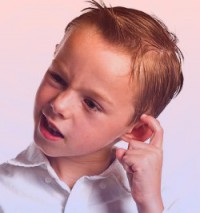Study measures disorientation in dyslexic children….

… but the researchers don’t seem to know that’s what happened.
Here’s what they do know: “[C]hildren who are poor readers have more variable neural responses to speech, reflecting an inconsistency in the brain’s response to sound from trial-to-trial.“
Or to put things more simply: the study showed that dyslexic kids hear word sounds inconsistently. (Rougly 90% of the kids labeled “poor readers” also had an independent diagnosis of dyslexia, so for purpose of this study it’s fair to equate dyslexia with “poor reader’).
It’s also highly likely that the kids were disorienting during the study, because the researcher had each kid listening to random speech sounds with an earbud in his/her right ear, while at the same time watching a movie and listening to the movie soundtrack with the other (left) ear.
What the researchers did:
The researchers recruited 100 children, age 6-13, who had normal hearing. The kids were divided into three groups base on their performance on a test of oral fluency. About 1/3 of the kids were determined to be poor readers.
The researchers performed an auditory brain stem response test (ABR) while the kids listened to “ba” and “ga” sounds created by a speech synthesizer. An ABR test measures the brain waves associated with hearing sounds, using electrodes attached to the scalp and earlobes. It’s painless, but the kids need to remain very still while the test is being done, which is why the researchers decided to let them watch movies. The dyslexic kids didn’t have to do anything — the researchers just wanted to see how their brains responded to the syllables when compared to the other kids, who were normal and good readers.
What the researchers found:
“poor readers had more variable brainstem responses to speech than did good readers“
Here’s what they think it means:
“Overall, our results suggest that neural inconsistency in response to sound is a biological mechanism that may contribute to reading impairment”
“it is likely that initial variability in speech sound representations led to weaker phonological development in the preschool years, and weaker phonological development failed to tune the auditory system to selectively represent meaningful speech sound differences as being important”
And here is what they say about the cause:
“Although causality cannot be determined, heightened variability in nervous system function may underlie fluctuations in directed attention and impaired speech understanding due to inconsistent encoding'”
(That’s scientist-speak for “we don’t know why”)
Ron Davis wrote, “The most consistent thing about dyslexics is their inconsistency.” In a way, I think that the more remarkable aspect of the study is that the non-dyslexic kids were so stable in their perceptions., and that their brains seemed to consistently react to meaningless speech sounds while the movie was running.
In any case, if the goal of the research had been to study disorientation, then testing the way the brain responds to sounds while the kids are distracted by a movie seems to be a good way to do it. The results lend clear support to Ron Davis’ findings that disorientation alters perception. I wish they had considered and addressed that possibility.
But as that wasn’t the goal, I’m not sure the study design makes sense. It’s more of a test of whether the dyslexic kids can do two things at once (watch & listen to a movie and at the same time attend to meaningless speech sounds) — than a test of the overall consistency of the dyslexic response. I’m not sure what might have happened if they had figured out some way of convincing the children to keep still during the test that didn’t put such demands on their attentional resources. (That’s my own science-speak that means that it’s just hard for some people to concentrate on a movie while others are talking at the same time).
I think sometimes researchers get so caught up in looking to prove their pet theory that they develop tunnel vision. In this case they want to prove some sort of physical or neurological connection to a phonological theory of dyslexia, and they have failed to account for psychological and environmental influences in their study design.
I personally have a lot of questions in my own mind about what was going on in the movies the kids were watching (action? dialogue? a complex plot to follow?) , but the researchers don’t bother with that part.
Here’s the study I’m writing about:
Jane Hornickel and Nina Kraus. Unstable Representation of Sound: A Biological Marker of Dyslexia. The Journal of Neuroscience, February 20, 2013•33(8):3500 –3504









